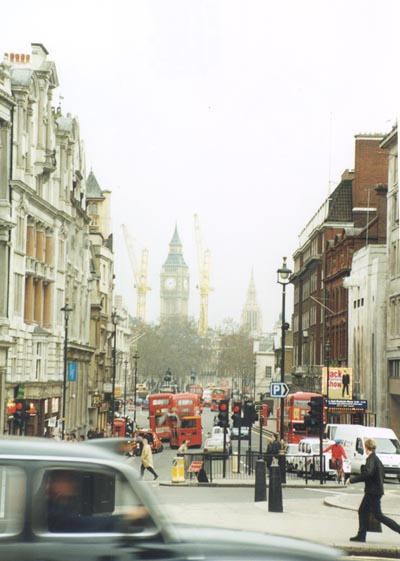

As for "Big Ben," there's some debate as to whether the nickname comes from Benjamin Hall, the first commissioner of Works, or from Benjamin Caunt, a famous boxer. The Big Ben is only one of five bells hanging in the clock tower, but at13 tons, it's the largest. The clock itself was designed by E.B. Denison & E.J. Dent and was completed in 1858. The clock tower reaches a height of no less than 96 meters.
Little known fact: The "Big Ben" bell is counterweighted with old pennies!
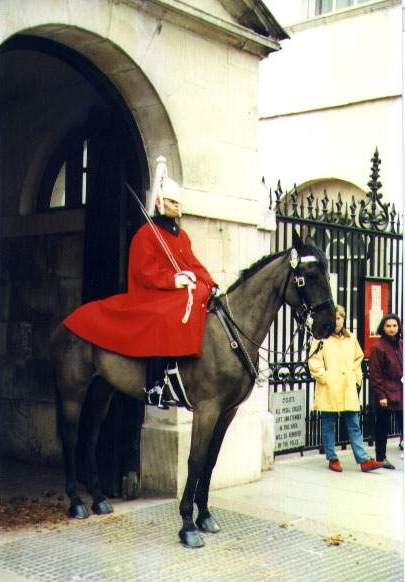
The walk down Whitehall took me past the Horse Palace, where I guess they used to keep the Queen's royal horses. There were a couple of guards on horseback outside, ever so regal.
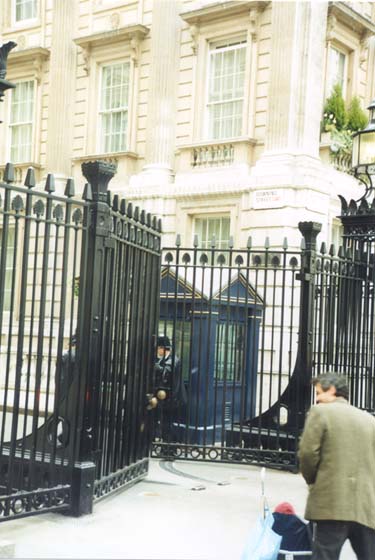
I also walked past Downing Street, where the Prime Minister lives. There's a fairly heavy-duty wrought iron gate blocking the entrance to Downing Street, and backed by several police officers with very serious expressions on their faces. Cool! I saw a car leave just as I was walking by; there's another barrier about fifty feet inside the gate, a concrete wall that can be raised and lowered into the ground, apparently to stop anybody who made it through the first gate. These people are serious!
I stood around for a minute or so, but they kept watching me, making me nervous (maybe I was making them nervous!), so I kept walking.
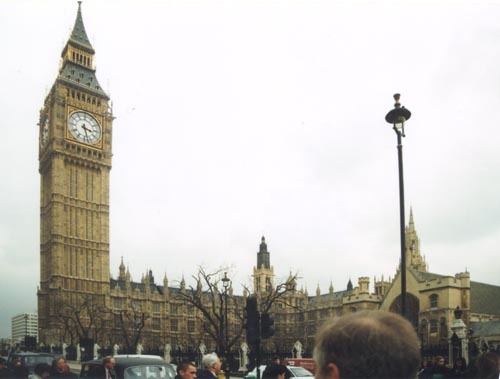
I went past Parliament, and there was a queue outside for admission to some session, I think. In any case, the walk along Whitehall was just packed, there were people jammed shoulder-to-shoulder all the way down to the Thames. And me with my love of crowds. NOT!

But crowds or not, it was worth it. What we today commonly call the Houses of Parliament was really first built as Westminster Palace, home to William II, back in the 11th century. The complex served as a royal abode until the 16th cent., when it was adopted as the assembly place for the House of Commons and the House of Lords.
Alas, in 1834 a huge fire destroyed the Houses of Parliament and many important buildings and records were lost. The only part that was saved was the old Jewel Tower and the great Westminster Hall. Today, Westminster Hall (with its great medieval timber roof) is the main entrance of Parliament and is used for important state occasions, while the Jewel Tower ...
Remember the postcards I'd written back in Hyde Park? Well, I dropped them into a letterbox right across the street from Parliament, and then I noticed there was an old building behind me, sort of off in the corner, and there didn’t seem to be anyone over there. I walked over, and found this great “secret” place, an older area of the original Palace of Westminster that wasn’t, apparently, high on the list for tourists to visit -- The Jewel Tower. It's very peaceful here. Not fifty feet away there are crowds of people up and down Whitehall, many of them waiting in line outside Parliament. But across the street ... there's just me. It was great!
Anyway, I'm now sitting on a bench not thirty feet from the Old Palace, the original Parliament building, in my own little private place across from Parliament. There are a few signs next to the pathway, and on the wall of this old building; here’s what the sign on the path says:
The Palace of Westminster formed the main residence of the Kings and Queens of England from the time of Edward the Confessor up to the reign of Henry VIII (1042-1547).
The Palace has undergone many changes and is now largely occupied by the Houses of Parliament.
The sign on the wall of my little building sanctuary place reads:
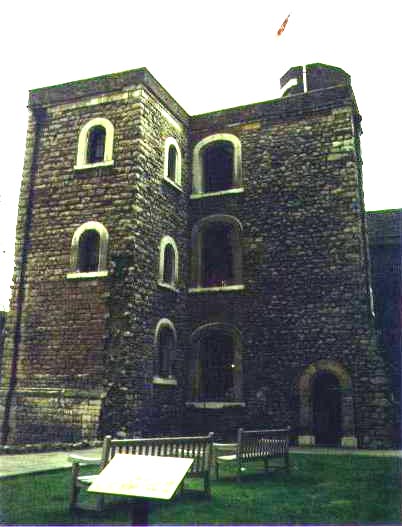
The Jewel Tower marks the south west corner of the Palace of Westminster, and was actually built on land belonging to Westminster Abbey.... It was built for Edward III ... in 1365-1366. It formed part of the King's private palace, and was designed to hold the sovereign’s private treasures.
From 1621 the Jewel Tower was used for the storage of Parliamentary records. It was used for this purpose for the next 250 years, until in 1869 it became the centre for the Board of Trade's Standards Department, testing standards of weight and measure.
Ah, what history! So I hung out for a while, but the sky was turning darker and darker and not so friendly. Also I had to go wee. So I walked back towards Parliament, searching for a loo. I took College Way, thinking it would wrap around and connect next to Westminster Abbey (cuz I knew there was a public loo across from the Abbey). But the road didn't wrap around, I noticed, just as it began to rain. With a vengeance. Fortunately, I had a brolly.
It is pounding rain! Okay, maybe not pounding, but considering the general gloominess and my full bladder, it feels pounding. I walked to Westminster Abbey, and of course the public facilities across the street were closed for maintenance. Just my luck.
So I walked to the bus stop, back up Whitehall, and took a bus back up to Trafalgar Square (there are very nice facilities in the Underground station at Trafalgar Square, if you ever find yourself in need, so to speak). Then I took the #12 bus up Regent Street, hoping it would be one that would go all the way back to Queensway, but my luck was holding and it only went to Oxford Street. Oh, well.
So I got off at Oxford Street, walked around a bit, then took the Tube from Oxford Circus to Queensway, and walked back to Harts the Grocer from there. Dinner was potato chips, chicken sandwich, pasta salad ("Scotland," with tomatoes and feta cheese; very good, actually), and milk ("skimmed"). Then I returned to the hotel for dinner, telly, and sleepy-bye.
There's an old Fodor's guide to Europe in my room ... I flipped through the section on London, just to see if there's anything interesting they recommend. Hey, the Hyde Park House is recommended as a place to stay! Actually, aside from it being a dump, it's not a bad place.
Note to myself: Go find "Ye Olde Mitre" pub. The book recommends it as worth checking out. 1 Ely Court, Ely Place off Hatton Gdn. EC1. Tube: Farringdon. Supposed to be good. On my list of places to visit, then.